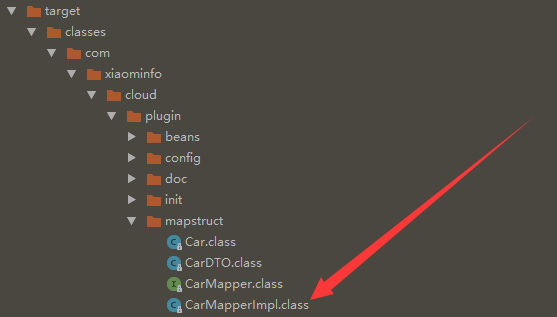springfox 源码分析(二) 初探mapstruct
时间:2019-5-22 12:40:21
地点:单位
前言
在继续阅读学习springfox源码之前,我们需要先来学习一下mapstruct这个组件,只有在理解了mapstruct组件后,后面再看springfox的源码才不会有疑惑
因为之前并没有接触过mapstruct这个组件,所以记录一下学习的过程.
mapstruct
GitHub:https://github.com/mapstruct/mapstruct
文档:http://mapstruct.org/documentation/stable/reference/html/
一言一概之:Java bean mappings, the easy way!
简介
通过上面的最简单的一句话,很清晰的描述了mapstruct的作用,主要用于Java Bean的映射,这有点类似mybatis中的对象关系映射,但此处的mappings并非mybatis那样
MapStruct同时也是一个代码生成器,它基于约定优于配置方法极大地简化了Java bean类型之间映射的实现。
通过MapStruct生成的映射代码使用普通方法调用,因此快速,类型安全且易于理解。
作用
我们为什么需要MapStruct组件?
我们的应用程序通常会使用分层结构,分层时每层的对象会有不同的POJO对象(例如实体DO和业务DTO),实体DO定义了程序内部的逻辑属性,而DTO定义了外部业务逻辑关系
通常我们在应用程序通过DTO接受进来外部参数时,需要将之转化为内部DO对象,供内部调用,此时MapStruct组件正为此而生.
与其他映射框架相比,MapStruct在编译时生成bean映射,可确保高性能,允许快速的开发人员反馈和彻底的错误检查。
示例
先来看一组关于MapStruct的示例
在maven中引入MapStruct框架的jar包
<properties>
<mapstruct.version>1.2.0.Final</mapstruct.version>
</properties>
<dependencies>
<!-- https://mvnrepository.com/artifact/junit/junit -->
<dependency>
<groupId>junit</groupId>
<artifactId>junit</artifactId>
<version>4.8.2</version>
<scope>test</scope>
</dependency>
<dependency>
<groupId>org.mapstruct</groupId>
<artifactId>mapstruct-jdk8</artifactId>
<version>${mapstruct.version}</version>
</dependency>
<dependency>
<groupId>org.mapstruct</groupId>
<artifactId>mapstruct-processor</artifactId>
<version>${mapstruct.version}</version>
</dependency>
</dependencies>
<build>
<plugins>
<plugin>
<groupId>org.apache.maven.plugins</groupId>
<artifactId>maven-compiler-plugin</artifactId>
<version>3.5.1</version> <!-- or newer version -->
<configuration>
<source>1.8</source> <!-- depending on your project -->
<target>1.8</target> <!-- depending on your project -->
<annotationProcessorPaths>
<path>
<groupId>org.mapstruct</groupId>
<artifactId>mapstruct-processor</artifactId>
<version>${mapstruct.version}</version>
</path>
<!-- other annotation processors -->
</annotationProcessorPaths>
<compilerArgs>
<compilerArg>
-Amapstruct.suppressGeneratorTimestamp=true
</compilerArg>
<compilerArg>
-Amapstruct.suppressGeneratorVersionInfoComment=true
</compilerArg>
</compilerArgs>
</configuration>
</plugin>
</plugins>
</build>
假设我们拥有DO和业务DTO对象Car.java、CarDTO.java
Car.java:
public class Car {
private String name;
private String make;
private int numberOfSeats;
//getter and setter ,constructs
}
CarDTO.java
public class CarDTO {
private int seatCount;
//getter and setter ,constructs
}
按照传统的转换关系,如果我们不使用MapStruct框架的话,使用方式如下:
Car car=new Car("c1","m1",12);
CarDTO cd=new CarDTO();
//赋值
cd.setSeatCount(car.getNumberOfSeats());
按照以上的方式会有以下局限:
- 如果属性很多的话,需要写大量的赋值属性代码
- 代码极其繁琐
如果使用MapStruct框架,我们可以先声明一个CarMapping接口
/***
*
* @since:spring-plugin-demo 1.0
* @author <a href="mailto:xiaoymin@foxmail.com">xiaoymin@foxmail.com</a>
* 2019/05/21 21:40
*/
@Mapper
public interface CarMapper {
CarMapper INSTANCE= Mappers.getMapper(CarMapper.class);
@Mapping(source = "numberOfSeats", target = "seatCount")
CarDTO carToCarDto(Car car);
}
我们将所有DO对象及DTO对象的映射关系都定义在Mapper接口中,然后通过@Mapper注解标注
而此时我们使用的话也会有所变化:
//given
Car car = new Car( "Morris", "4make", 13 );
//when
CarDTO carDto = CarMapper.INSTANCE.carToCarDto( car );
//then
System.out.println(carDto.getSeatCount());
此时,我们程序在compile编译时,MapStruct框架会为我们自动生成CarMapper的实现类:

此时在generated-source也会生成相应的java文件
CarMapperImpl.java
@Generated(
value = "org.mapstruct.ap.MappingProcessor",
date = "2019-05-21T21:46:10+0800",
comments = "version: 1.2.0.Final, compiler: javac, environment: Java 1.8.0_111 (Oracle Corporation)"
)
public class CarMapperImpl implements CarMapper {
@Override
public CarDTO carToCarDto(Car car) {
if ( car == null ) {
return null;
}
CarDTO carDTO = new CarDTO();
carDTO.setSeatCount( car.getNumberOfSeats() );
return carDTO;
}
}
映射接口自动帮助我们实现了Java实体的转换
总结
了解了mapstruct的功能,我们在接下来学习springfox的源码时会轻松很多.